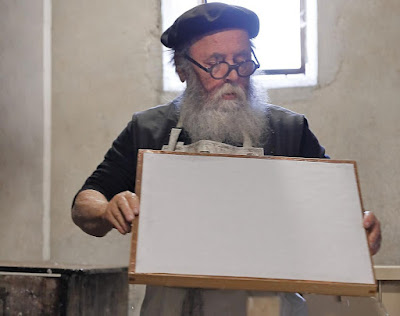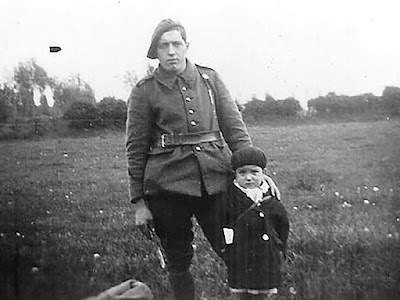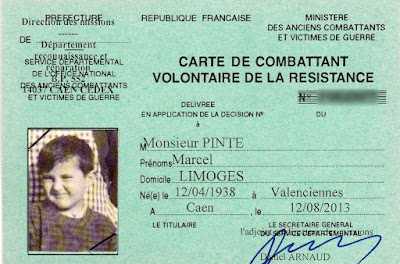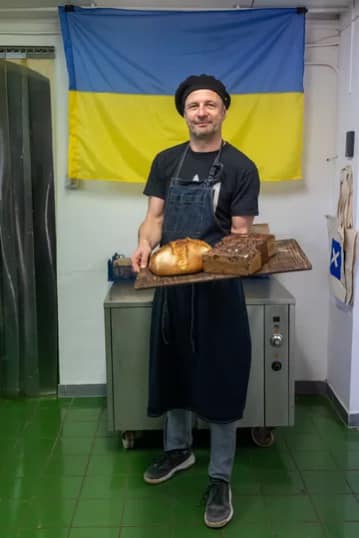New additions to my collection of beret labels (500+ and counting).
Saturday, April 30, 2022
Friday, April 29, 2022
Aethereal Berets
Aethereal (adjective)
1. light, airy,
or tenuous:
an ethereal
world created through the poetic imagination.
ethereal
beauty.
3.heavenly or
celestial:
gone to his
ethereal home.
4. of or relating to the upper regions of space.
Thursday, April 28, 2022
A German Look on French berets
This beautiful video deals with all clichés about Frenchmen and berets in particular.
It is also full of interesting information about the Basque beret (and it looks like the author must have visited The Beret Project regularly during his creating process).
Unfortunately the text is in French, but a translation follows below:
Hans
Biedermann from Buxtehude finds himself very embarrassed on leaving the Louvre.
He is looking for someone to ask how to get to the Musée d´Orsay. However, he sees
only easily recognizable tourists. Japanese cameras, Americans wearing baseball
caps, Germans wearing Birkenstocks and gesticulating Italians.
Among all
these foreigners, how can Hans Biedermann from Buxtehude detect a real Frenchman?
The answer is very simple, everyone knows, thanks to countless cartoons, what a
real Frenchman looks like.
We recognize
him thanks to his moustache, the baguette he holds under his arm, the bottle of
red wine which sometimes protrudes from his pocket, but above all thanks to the
Basque beret, permanently screwed on his head.
This headgear is so typical of France that in Germany it is even called "French beret" or downright "French lid". Hans Biedermann from Buxtehude goes straight to the first Basque beret wearer.
And then,
disappointment! The man comes from Neckar-Steinach and worships Che Guevara. The
second beret wearer alas, is also German. He is a Francophile teacher, eco-friendly,
green.
As for the
third bearer of a Basque beret, no doubt, it can only be a Frenchman.
He also
carries a baguette under his arm. But disappointment once again. This Frenchman
is none other than a young alternative from Berlin.
Hans
Biedermann from Buxtehude draws the following conclusion from this adventure:
those who wear this typical French headgear are in fact German intellectuals; Francophiles
who abhor both German hats and ridiculous baseball caps.
But why is
this hat called “Basque beret”? This denomination comes from Emperor Napoleon
III. While he was staying in the Basque Country with the Empress Eugénie, he
noticed these berets and wrongly called them “Basque berets”.
And as no one dared to contradict the Monarch, the term imposed itself. In fact, the beret is a particularly appreciated hat in the South-West of France: in Béarn, Gascony and the Basque Country.
Originally
knitted in wool, it was mainly worn by shepherds in the Pyrenees. Practical,
indestructible, easy to fold or roll up to be stored in a pocket, it was
adopted by many armies around the world.
In France,
in the 1940s, the beret was in vogue and it was worn in almost all
the country.
So much so that in Alsace-Lorraine, during the German Occupation, wearing a beret
became a symbol of the Resistance and therefore ended up being banned there.
But
ironically, the French Militia, this sinister brigade composed of the worst
collaborators,
and who fought the resistance by the cruellest means, also adopted this
typically French headgear.
And yet, the
beret has not disappeared. And even this headgear which has meanwhile become a
real classic, regularly returns to the fore. Even if is only on the heads Germans…
Wednesday, April 27, 2022
Jacek Polewski -Boinero Exceptionel!
This is Jacek Polewski - a baker who left his hometown of Poznan in Poland for Bucha in Ukraine, to bake bread for soldiers and residents.
He found the abandoned local bakery "Baker's House", where he will work; he loaded 500 kilograms of flour into his car and left. On the way, in Lviv, he bought another 600 kg so that all the residents would have enough bread.
During the war, Mr. Jacek supported refugees in every possible way, helped as much as he could, but when he saw a photo of the massacres in Bucha, he decided to go there.
Tuesday, April 26, 2022
Monday, April 25, 2022
The Tartan 11.5" SPECIAL!
The Czech Service Star has been in production for decades, but is now only made on special order. South Pacific Berets has done so and stocks the Service Star in black, navy, winter-green and "mammoth" (the last two not available anywhere else, not even in the Czech Republic).
This is a kind of hybrid beret; with the size of a large diameter Basque beret in 11.5" or 29.2cm, while having a military style leather rim with drawstring and three air vents on the side. A very well finished beret with an exceptional tartan lining.
The Service Star is a seriously comfortable and pleasant beret to wear; the leather headband can be worn "military style" with the rim outwards, or "Basque style", with the rim folded inwards.
This week only, at a massive 40% discount from $49.95 @ $29.95.
Sunday, April 24, 2022
Saturday, April 23, 2022
Antonio Fraguas (Fraguas)
Antonio
Fraguas Fraguas was born in Insuela, Galicia, on December 28, 1905, and died in
Santiago de Compostela on November 5, 1999.

He was an
important Galician historian, ethnographer, anthropologist, and geographer. In
1923 he and some of his fellows founded the Sociedade da Lingua, whose main
goals were the defense of the Galician language and the creation of a
dictionary. He was a member of Irmandades da Fala and Seminario de Estudos Galegos
and was high school professor after the Spanish Civil War broke out.
Friday, April 22, 2022
Thursday, April 21, 2022
Joe Hollis of Mountain Gardens
MountainGardens is a botanical garden of useful plants featuring the largest collection of native Appalachian and Chinese medicinal herbs in the Eastern US, organically grown at the foot of the Black Mountains in Western North Carolina.

Their specialties
include native and oriental medicinal herbs, wild foods, perennial vegetables,
craft plants and other ethnobotanicals. They offer for sale seeds, plants,
fresh and dried herb material, and other preparations and present useful
information regarding the cultivation and uses of these species, as well as our
philosophy of Paradise Gardening.

Joe Hollis
has been engaged in developing a Paradise Garden for the past 25 years.

Wednesday, April 20, 2022
Jacques Bréjoux (2)



It does not receive or request any subsidy.

Tuesday, April 19, 2022
Marcel Pinte
Marcel Pinte
was born in Valenciennes in April 1938. His father, Eugene Pinte, was a local
resistance leader who used his farmhouse in Aixe-sur-Vienne to receive coded
messages from London and coordinate parachute drops in a field nearby.

From a young age Marcel acted as a courier for local resistance fighters. He was given the nickname "Quinquin" after a children's song.
He was killed, aged six, on 19 August 1944 when he was hit by several bullets from an unintentional discharge by a Sten gun shortly after a large group of resistance fighters had landed by parachute.

In 1950, he was awarded the posthumous rank of Sergeant in the Resistance. In August 2013, the National Office of Former Combatants and War Victims delivered a card for "volunteer combatants of the Resistance" in the name of "Monsieur Marcel Pinte". On Armistice Day 2020, Pinte was honoured in a special ceremony in which his name was inscribed on the war memorial of Aixe-sur-Vienne near Limoges.
Monday, April 18, 2022
Rugby
Sunday, April 17, 2022
Citroën Traction Avant during WWII
One of my all time favourite cars is the Citroën Traction Avant. Growing up in the ‘60s Netherlands, these were still a fairly common sight.
The umbrella-name
Traction Avant was used for a range of mostly 4-door saloons and executive cars
(7, C11, C15/6), with four or six-cylinder engines, produced by the French
manufacturer Citroën from 1934 to 1957. Approximately 760,000 units were
produced.
The Traction
Avant pioneered mass-production of a crash resistant, unitary, monocoque body.
Additionally, the car was also an early adopter of rack and pinion steering.
Although the
car's name emphasized its front-wheel drive power delivery ("Traction
Avant" literally means “front traction”), the car stood out at least as
much by its much lower profile and stance – made possible by the absence of a
separate chassis under the car's unitary body – sharply distinguishing it
visually from its contemporaries.
During the
war years the Traction was much loved, first by the French army, then the
occupying Nazi’s (who typically preferred the Traction over their own German
vehicles) and took it as far as Norway and the Soviet front.
All these photos
depict the Traction in use by the French military in the years 1938-1940.










































